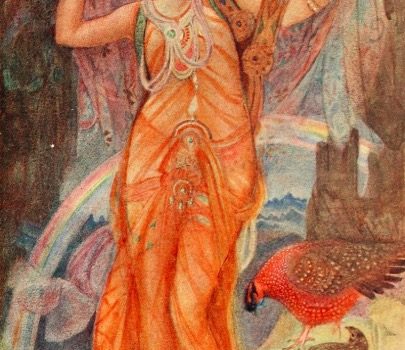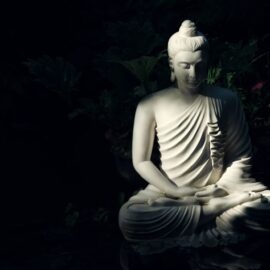

This article is an excerpt from the Shortform summary of "The Hero with a Thousand Faces" by Joseph Campbell. Shortform has the world's best summaries of books you should be reading.
Like this article? Sign up for a free trial here .
Who is the goddess Inanna? How does Inanna’s journey to the underworld follow the hero’s journey, as described in Joseph Campbell’s The Hero with a Thousand Faces?
We’ll cover the Sumerian goddess Inanna’s journey to the underworld and how it conforms to the template of the hero’s journey.
Descent into the Underworld
Before we look at the story of the Sumerian goddess Inanna, let’s look at one common feature of mythology: the descent into the underworld. This will be important to understanding the story of Inanna. In mythology, the hero’s journey often requires entering the underworld or the land of the dead.
Psyche and Her Tasks
In the ancient Roman novel Metamorphoses, Psyche pleads with the goddess Venus to release her lover Cupid (the goddess’ son) so that the two can be married. Venus beats Psyche and orders her to conduct a series of tasks:
- First, she orders Psyche sort an enormous quantity of foodstuffs before night. Thankfully, an army of ants helps Psyche accomplish her task (supernatural aid).
- Next, Psyche must collect golden wool from a flock of wild sheep whose bites carry deadly venom. Fortunately, a green reed shows her how to obtain the wool without being poisoned.
- Next, Psyche must retrieve water from a spring at the top of a high mountain guarded by dragons. Once again, she’s aided by an eagle who helps her fetch the water.
In her final and most fearsome task, Psyche is told to descend into the underworld and bring back a box full of supernatural beauty. There are many parallels between Psyche and the Sumerian goddess Inanna. Psyche’s last supernatural helper, a high tower, instructs her how to safely go down into the underworld and gives her charms and amulets to ward off the demons and hell-hounds she will encounter there. In doing so, she earns the elixir of mortality, which will enable her to live with Cupid forever in Paradise.
Sumerian Goddess Inanna and the Hero’s Journey
The oldest story of descent into the world of death comes from the world’s first civilization—the ancient Sumerians of Mesopotamia, in what is now Iraq. The goddess Inanna goes down to the underworld, guarded by her sister (and enemy) Ereshkigal. At each of the seven gates of this hell, Inanna is ordered by the gatekeeper to remove a part of her clothing—in due course, she removes her crown, rod, necklace, stones, breastplate, ring, and garments, finally presenting herself naked before the judges of the underworld.
The dual image of the two sisters, goddess Inanna and Ereshkigal, is important. Indeed, duality is a common theme in mythology. The hero often finds the monster to be an aspect of themselves. This is because all journeys are ultimately about identifying and conquering a new aspect of the self. As we’ve seen, this is often done through the act of swallowing or being swallowed.
Outside Intervention
Sometimes, the hero will require aid from a third party in order to return home from the realm of the supernatural. The hero, indeed, may need to be rescued himself.
The Escape of Inanna
The Sumerian goddess Inanna descended into the underworld, guarded by her sister/double Ereshkigal. When she goes down, she leaves instructions for her messenger Ninshubur to rescue her if she fails to return. When we left her, she was left to face the seven judges of the underworld, as she stood naked before them. The judges turn Inanna into a snake and then fasten her to a stake, where they leave her for three days and three nights.
Alarmed, Ninshubur puts goddess Inanna’s rescue plan into action. He goes to the god Enki, who creates two sexless creatures who bring the food of life and the water of life to sprinkle over Inanna’s corpse. This causes Inanna to rise up and ascend from the underworld, with an army of demons at her side, with whom she wanders through the streets of all the cities of Sumer.
———End of Preview———

Like what you just read? Read the rest of the world's best summary of "The Hero with a Thousand Faces" at Shortform . Learn the book's critical concepts in 20 minutes or less .
Here's what you'll find in our full The Hero with a Thousand Faces summary :
- How the Hero's Journey reappears hundreds of times in different cultures and ages
- How we attach our psychology to heroes, and how they help embolden us in our lives
- Why stories and mythology are so important, even in today's world






